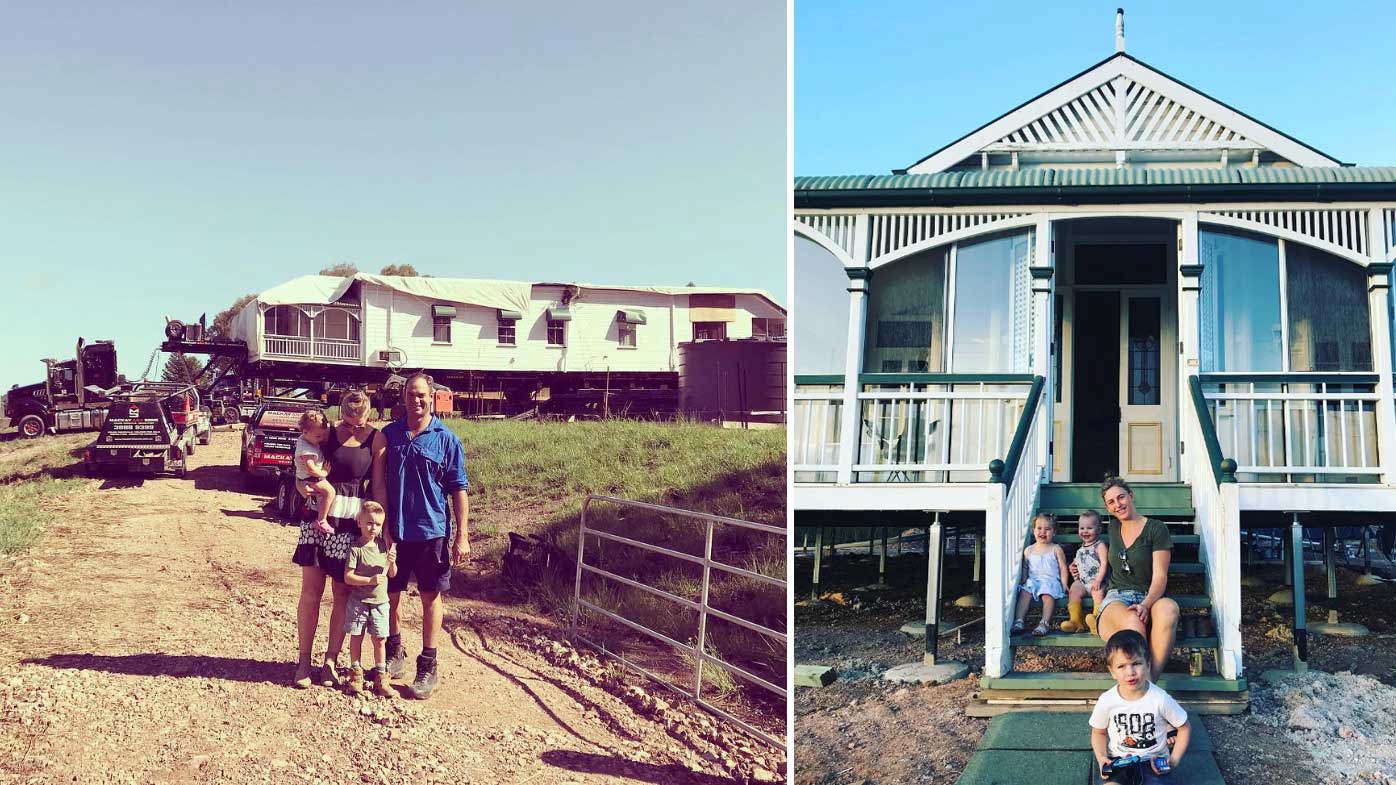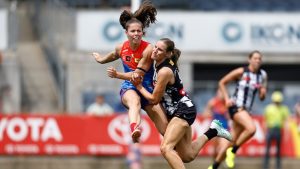
When Keirra and Chris Massoud bought their block of farmland in Mary Valley on Queensland‘s Sunshine Coast it was an empty slate.
“There was no house, no driveway, nothing,” Keirra said.
Rather than building a new, modern house on the site, Keirra had her heart set on something a bit different that would feel more at home in the bucolic landscape.
“My husband wasn’t really up for the idea, but I was in the background trying madly to find an old house, a Queenslander that we could buy and move there,” Keirra said.
READ MORE: How Australia’s housing market compares to the rest of the world
Keirra and Chris would go on to be at the forefront of what has become a popular trend and booming industry in recent years – the rescue, sale and relocation of Queensland’s iconic timber cottages.
After many months of searching, it was through an ad on Gumtree that Keirra finally found their dream home, back in 2017.
“I just loved it from the moment I saw it,” she said.
“There weren’t many pictures, maybe only five in total. But I loved the façade and the big verandah and the bull nose front.”
The 1930s Queenslander was in the town of Narangba, Morton Bay, about 150 kilometres south of their farm.
The owner of the home had sold his property, but struck an agreement with the developer so that he could save his dearly-loved house, part of which he had built himself.
“It took me two weeks to pluck up the courage to ring the man because I didn’t really know what it would mean if we even started down that track,” Keirra said.
“He was so lovely, and he said I was the first person to call. I couldn’t believe it.”
READ MORE: Aussie architect unveils DIY house, which can be built in six months, for $150k
When Keirra and Chris went to inspect the house in person, they were so impressed with the quality of the home and its condition they agreed to buy it on the spot for $100,000.
“It was quite scary and a bit risky, but we shook on it on the day,” Keirra said.
“When you’re buying a house off Gumtree, it’s like getting a secondhand car. There’s no due diligence or any type of protections, you just have to go and try and work out how to make it happen.”
The couple paid an extra $50,000 to have the house chopped in half, placed on the back of a truck and transported overnight to the farm by an experienced company.
The price included restumping the home at its new location, but not council fees and permits, which increased the total cost of the project to around $200,000, she said.
One of the scariest aspects of the relocation process was that the home couldn’t be insured while it was on the road, Keirra said.
Despite their fears, and the torrential rain that poured down during the move, the relocation went relatively smoothly.
Since then, the house has been a labour of love for the couple who have been slowly renovating it over the years, between raising their three children and managing the cattle breeding farm.
Just after the move, the house was repainted and the floor plan adjusted to make it more open. A new kitchen, guest room and bathroom have since been added.
Keirra said their Queenslander now felt right at home on the farm and being able to rescue a piece of history had been a special experience.
Buying a relocated Queenslander had also allowed them to own a house with timber finishings of a quality they otherwise wouldn’t have been able to afford, she said.
“We had a builder come and visit recently. He’s estimated that to build that house now would be around the $2 million mark, just with all the timber work and everything,” she said.
“We took a risk and it paid off. It’s a beautiful house, and we’re lucky that we found it on Gumtree and were able to get it to our farm.”
‘Half the price’ of a new build
John Wright has been working in the house relocation industry for decades, and now runs the family business Queensland House Removers.
As well as relocating properties, Wright also scouts and buys moveable properties which he sells to customers.
Wright told 9news.com.au business was booming, with more and more homebuyers seeking out relocatable homes because of their affordability.
“In the last five years, we’ve probably doubled the amount of work we’ve been doing. It’s been a fair increase,” Wright said.
“One of the reasons it’s become so popular is that it’s affordable, our houses are a lot cheaper,” he said.
“You’re looking at half the price of building the same house new. It can be popular with investors as they can get almost the same rent whether they are old or new but spend half the money.”
The main stumbling block for buyers was needing to pay cash for the house up front, Wright said.
Banks and other lenders typically refuse to offer a loan until the house is moved to its new location.
“This often eliminates first-time buyers, which I think is disgusting, because it’s a much more affordable option,” Wright said.
The cost of moving a house varied from between $30,000- $40,000 for a small home which did not need to be cut in two, to about $50,000-$60,000 for a larger house, Wright said.
Restumping a property on new foundations can cost an extra $15,000 – $20,000.
Another advantage of buying a relocatable home was that it was far quicker than building a new one from scratch, Wright said, with council approvals usually taking less than three months.
From ‘graveyard’ to beachfront
Adela and Nigel are another Queensland couple who have gone down the route of buying and relocating an old Queenslander.
When the Brisbane pair bought an empty beachfront block of land on Bribie Island in 2018 as an investment they looked at all the different housing options.
“Building a new house was going to take a long time and the price of materials was starting to go up,” Adela said.
“We looked at kit homes. But my husband has always had this obsession with old things, so that is why we started looking at all the beautiful Queenslanders that just get taken off blocks and replaced with big new houses.”
Adela said she and her husband began to visit what they coined the “Queenslander graveyards” – highway sites where housing relocation companies display second-hand homes for sale.
Eventually, they found the one they were looking for.
It was a run-down, 1920s Queenslander which had travelled 150 kilometres from its original location in the rural town of Amamoor, near Gympie.
“It was in horrendous condition, it was pretty gross, but the bones were good and that’s what we looked at,” Adela said.
The moving process was complicated by the home’s new location on Bribie Island, which is only accessible via one bridged road.
“They had to close down the bridge in the middle of the night for the move, it was quite complicated,” Adela said.
“We had to get a permit from council and all the neighbours were in uproar because of this house getting moved on there.
“They all thought we were mad, but afterwards they were like, ‘Oh my gosh, this is amazing’.”
The entire project, including renovations, took about 6-8 months to complete, Adela said.
The cost of the house, including its relocation and renovation, came to roughly half of a new build at $300,000, she added.
“It is much more economical. If we were going to build something quite basic back then, a little beach cottage, we wouldn’t have been able to get anything under $600,000,” she said.
Then there was the added satisfaction of giving an old home on death row a new lease on life, Adela said.
“I think for us personally, taking something old that has been discarded and bringing it back to life so it can be reused again is really important,” she said.
“You do start to fall in love with the process, you’re uncovering things and you put so many hours into rebuilding something.”
While the Brisbane family-of-five was tempted to go against their original plans and make the Queenslander their permanent home, practicalities meant they have since put it on the AirBnB market.
Do you have a story? Contact reporter Emily McPherson at emcpherson@nine.com.au
links to content on ABC
9News





